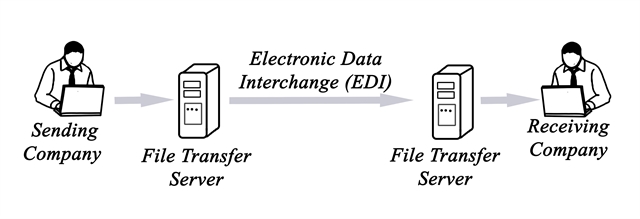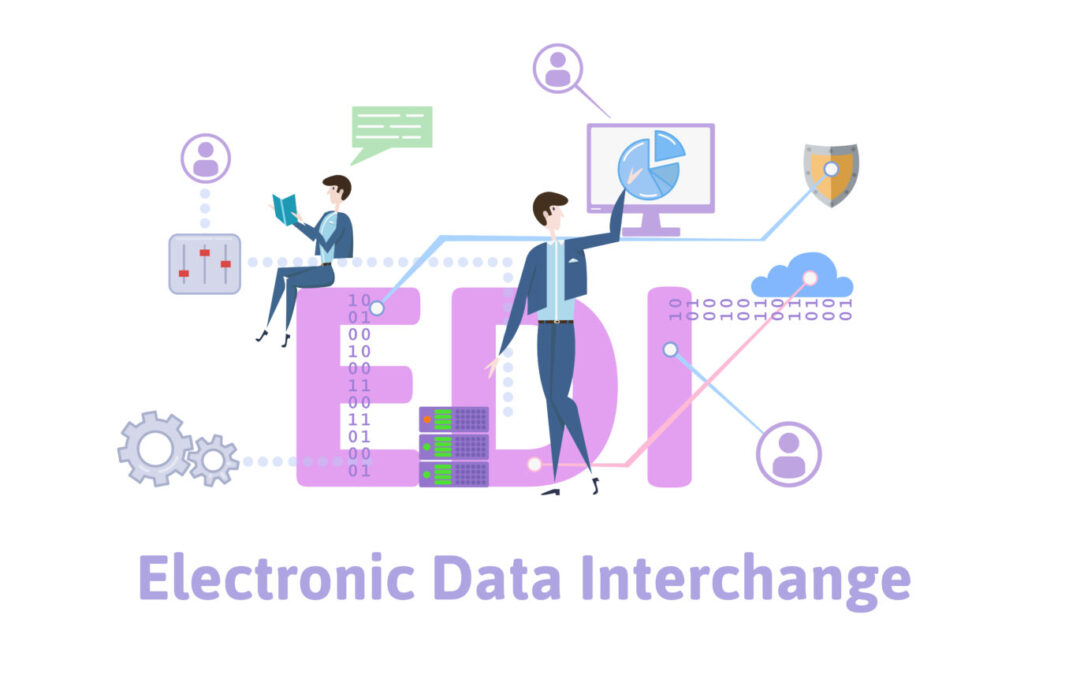“EDI Solutions for Businesses”… Feeling a bit overwhelmed by the complexity? Worry not! Our expert Devin from DataAutomation is here to simplify this essential business tool for you.
Let’s think of Electronic Data Interchange (EDI) as a universal translator in a room full of people who speak different languages.
Without a universal translator (EDI), each person (the retailer and the supplier) would have to figure out how to communicate their needs and understand the responses they get – this might involve slow methods like trying to learn basics of the other’s language, using hand signals, or hiring an interpreter (like sending an email or a fax, and manually entering data). The room quickly becomes chaotic, conversations are slow, and there’s a high chance of misunderstanding each other.
With a universal translator (EDI), however, everyone in the room can understand each other instantly, regardless of the language they speak. The translator instantly converts the message from the sender’s language into the recipient’s language (like the retailer’s purchase order into the supplier’s system). The conversation becomes smooth, fast, and accurate – everyone understands what’s being said immediately and can respond in kind. That’s what EDI does for businesses – it allows different computer systems to understand each other quickly and accurately, streamlining the process and minimizing errors.

EDI Solutions for Businesses: An Introduction
Electronic Data Interchange (EDI) is the backbone of many modern businesses. As an EDI solutions provider, we understand that this standardized process for transferring data between different computer systems or networks plays a crucial role in a wide range of industries. EDI:
Ensures seamless communication between business systems
Provides a common language for data interchange
Enables businesses to operate more efficien
Benefits of EDI Systems for Businesses
EDI brings numerous benefits to businesses. For example, it enhances efficiency by allowing seamless and rapid transfer of data, saving time over traditional communication methods. EDI solutions for businesses can also minimize the potential for human error by eliminating manual data entry. Furthermore, EDI reduces paperwork and the associated costs of paper, printing, storage, and postage. The advantage of real-time data exchange through EDI can also significantly enhance decision-making and planning processes. Some of the key benefits include:
- Efficiency: Rapid transfer of data saves time
- Accuracy: Reduces potential for human error
- Cost Reduction: Lowers expenses related to paperwork
- Improved Business Relationships: Enhances relationships with trading partners through quicker, more accurate data exchanges
- Real-time Data: Enables enhanced decision-making and planning
How Does EDI Work in Business?
Understanding EDI transactions begins with understanding how EDI works. The process involves four key steps:
- Preparation of Documents: Businesses convert their documents into a format compatible with EDI. This includes purchase orders, invoices, shipping notices, etc.
- Translation of Documents: These documents are translated into a standard EDI format using EDI software. This step converts business data into a string of numbers and letters that represent specific types of information.
- Transmission of Data: The EDI data is then transmitted to the recipient’s computer system using a secure network.
- Processing of Documents: The recipient’s computer system decodes the EDI data back into business documents, allowing for their easy use within the business application.
EDI Systems for Small Businesses
Small businesses might think that EDI is beyond their scope, but this isn’t the case. EDI solutions for businesses extend to all sizes. Smaller companies can benefit significantly from the cost savings and efficiency improvements EDI can bring, just like their larger counterparts
For Small Businesses:
- EDI can help streamline operations
- It can significantly reduce errors
- It can lead to cost savings through improved efficiency
Understanding EDI Transactions
At the heart of EDI are transactions – these are the specific messages or documents exchanged between businesses. These could include purchase orders, invoices, or shipping notices, to name a few. Each transaction type has a specific code in the EDI standard, ensuring that all businesses using EDI understand the nature of the document being exchanged. Understanding EDI transactions involves:
Recognizing the different types of documents exchanged
Understanding the specific EDI code for each transaction type
Understanding how these transactions flow between businesses
EDI Implementation Guide
The first step to implementing EDI in your business is understanding your business’s unique needs. This includes the type of documents you will be exchanging, the volume of transactions, and the capabilities of your trading partners. From there, you can choose the appropriate EDI software for businesses and begin the process of integration.
3 Easy Steps to Get Started:
- Assess your business needs
- Choose the right EDI software
- Begin integration with your business processes
EDI for Beginners
If you’re new to EDI, don’t worry – it’s not as complex as it might first seem. By leveraging the right EDI solutions for businesses, you can streamline your business transactions and improve overall efficiency.
Quick Tips:
- EDI is a tool to improve business efficiency
- It’s about choosing the right EDI solutions for your business
- You can significantly improve your business processes by properly implementing EDI
EDI Software for Businesses
There is a range of EDI software available to suit different business needs. From cloud-based solutions perfect for small businesses, to complex on-premises software designed for large enterprises with high-volume transactions.
EDI Integration in Business
The key to EDI success lies in proper integration. This involves setting up your business processes and computer systems to work seamlessly with EDI transactions. A well-integrated EDI system can result in streamlined operations and significant cost savings.
Effective EDI integration involves:
- Seamless setup of business processes
- Smooth interaction between your computer systems and EDI transactions
- Constant monitoring and improvement
EDI Standards in Business
EDI standards are globally accepted protocols that ensure all EDI solutions for businesses can ‘speak’ the same language. They define the structure and content of business documents for exchange and are critical to ensuring successful EDI implementation.
Key aspects of EDI standards include:
- Global acceptance for cross-border business transactions
- Clear definitions for document structure and content
- A crucial role in successful EDI implementation
Interchanging EDI with DataAutomation using SFTP: Enhancing EDI Solutions for Businesses
Secure File Transfer Protocol (SFTP), also known as SSH File Transfer Protocol, is a network protocol that provides file transfer and manipulation functionality over a reliable and secure data stream. It is part of the broader range of capabilities offered by the Secure Shell protocol (SSH).
Here at DataAutomation, we offer a system that can interact seamlessly with EDI using SFTP, providing businesses with an additional level of security and reliability for their data exchange processes. Here’s how this works:
- Secure Data Exchange: SFTP provides a secure channel for transmitting data. This is especially important for businesses handling sensitive data like customer details, financial information, or confidential business data. With SFTP, all data exchanged between your system and EDI is encrypted, ensuring it can’t be intercepted or viewed by unauthorized parties.
- Reliable File Transfer: SFTP ensures that data isn’t lost or corrupted during transfer. This means that all your EDI transactions will be accurately received as they were sent, preserving the integrity of your business data.
- Integration with DataAutomation: DataAutomation can be set up to send and receive files via SFTP. This means we can automatically pull data from your business systems, translate it into the correct EDI format, and then send it securely using SFTP. Similarly, we can receive EDI transactions via SFTP, translate them into a format your systems can understand, and then automatically import them.
By leveraging the combination of DataAutomation and SFTP, businesses can ensure their EDI transactions are not only efficient and accurate but also secure and reliable. This can be especially beneficial for businesses in industries where data security is paramount, such as finance, healthcare, or e-commerce
Wrapping Up
We hope this comprehensive guide has helped demystify EDI solutions for businesses and highlighted the significant benefits they can bring to your operations. Remember, EDI isn’t a one-size-fits-all approach, and at DataAutomation, we’re dedicated to providing solutions tailored to your unique needs.
Explore more valuable insights and stay updated on the latest trends by visiting our Blog.
Interested in integrating EDI solutions into your business? We would love to assist. Contact us here and our team will be more than happy to guide you through the process.
Let’s work together to streamline your data exchange and boost your business efficiency with EDI solutions.
“Taking the busyness out of your business”

Free E-book
Check out our free E-book for more info below!
More Blog Content!
- Time Saving eCommerce Hack 2025Wrapping Up Our 2024 Year Time Saving eCommerce Hack 2025 Whether you’re running an eCommerce store, managing inventory, or handling complex workflows, the systems… Read more: Time Saving eCommerce Hack 2025
- Out of the Box Versus Custom IntegrationWrapping Up Our 2024 Year Out of the Box Versus Custom Integration Integration is key to keeping your business operations smooth and efficient. Whether… Read more: Out of the Box Versus Custom Integration
- Wrapping Up Our 2024 YearWishing You a Joyful Holiday Season from DataAutomation…


Recent Comments